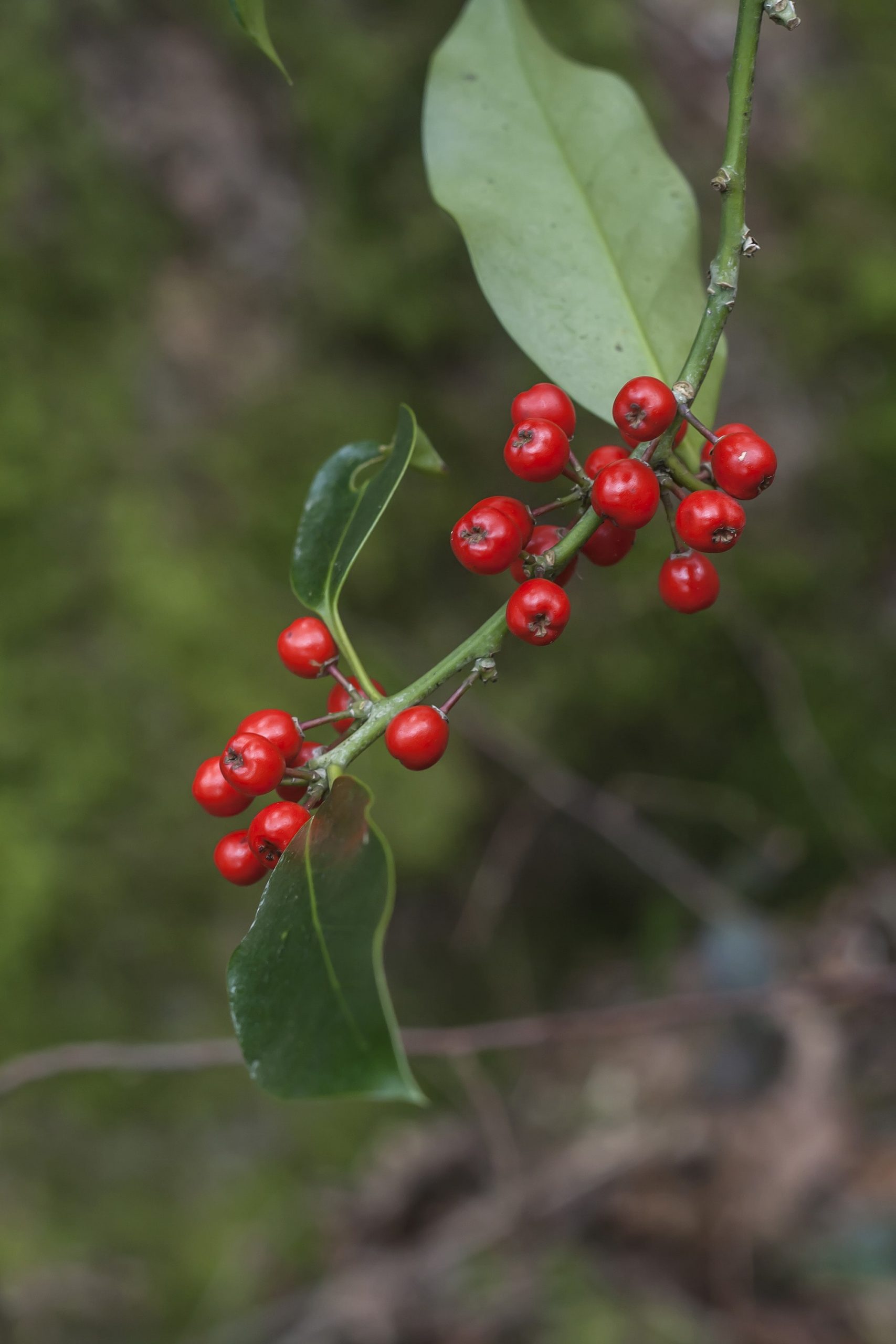English Holly
Characteristics

English holly (Ilex aquifolium) is an evergreen tree or shrub with leaves that are stiff, glossy, wavy, and spiny. Between April and June, they bloom small flowers that are white, 4-petaled, grow in clusters, and smell sweet. Their classic orange to red holly berries grow in clusters and last through the winter. The leaves can resemble Oregon grape leaves, especially on young plants that aren’t yet tree-like. But English Holly leaves tend to grow in an alternate pattern along the branches where Oregon grape grows long compound leaves, several pairs of leaflets along the leaf stem (rachis), and a single leaf at the end. English holly can grow anywhere from 15 to 50 feet in height and can be tree-like with a single stem or thicket-like with multiple smaller stems. Its berries are eaten and the seeds are spread by birds. The berries are toxic to people and pets. English holly roots can go very deep and a plant can also spread with suckers. If they are cut close to the ground, the plant is likely to sprout hundreds of suckers from its roots, creating a dense thicket. It grows anywhere the soil is well drained and thrives in both sun and shade.
Why is it here? Why don’t we want it?
English holly is native to Europe and is still commonly used in landscaping as an attractive evergreen shrub. It was likely introduced in the late 1800’s. One of the early English holly plants introduced to the Pacific Northwest was planted in Portland Oregon in 1874 and is still thriving today. English holly was also grown commercially to produce holly for Christmas decorations. If you’re interested in the history of English Holly production, you can find more information here.
English holly has spread well beyond our gardens and agricultural production into the understory of forests. In many places it is more common to be found in the forest understory than native evergreen trees. This indicates that as older deciduous trees die, they are more likely to be replaced with English holly than a native tree. The ability of English holly to replace many of our native trees leads to a displacement of native plant species, a decrease in biodiversity of both the forest understory and canopy, and a reduction in diverse habitats and food sources for wildlife.
What is Oxbow doing about English holly?
At Oxbow, English holly is a zero tolerance weed in our lowland forests. But unfortunately, it is well established in pockets of our upland forests. Currently we haven’t prioritized removing these trees from our uplands. We are just monitoring their spread. Our lowlands are relatively holly-free and we intend to keep it that way. When we find English holly seedlings, we are quick to pull them by hand or use a weed wrench while they are still small enough to do so.
Since mature holly is so difficult to manage manually and mechanically, we are still considering our options for controlling it in our uplands. Where trees are established, holly is very hard to get rid of since cutting them leads to massive re-sprouting. Also, digging up the roots of established trees creates a lot of ground disturbance. One strategy is to cut the trees back and then mow the re-sprouts regularly. But this is unlikely to kill the plants completely and would require following a strict mowing schedule to prevent holly from forming thickets. Cutting and injecting herbicide into the stump is a more effective strategy with potentially less impacts to the surrounding environment. Although we always try to find a non-chemical tool to get rid of our weeds, this is an option that we are considering.
What you can do about English holly on your property
This is up to your preference and the city that you live in. Some cities have banned private landowners from planting English holly. But there is no county-wide rule against growing holly as an ornamental tree. If you do decide to remove English holly from your property, be very aware of its tendency to re-sprout with cutting. Have a plan in place to regularly remove the suckers. Or better yet, dig out the roots. All plant parts except for the seeds can be left off the ground to dry out and die. Or all parts of the plant can be disposed of in your yard waste.
Although we usually discourage the use of herbicides, English holly may be an exception to this rule. Herbicide could be the better, less disruptive option for your site if the holly is well established. The only effective way to apply herbicide is by cut stump or frilling. The waxy leaves easily repel any herbicide that is sprayed on their surface. For more information, check out King County Noxious Weeds.
